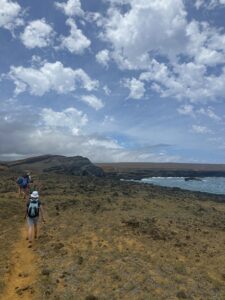Papakōlea Beach might just be my favorite spot so far. Papakōlea Beach is one of two green sand beaches in the United States and one of only four green sand beaches in the world, and Papakōlea in particular has quite a bit higher green sand concentration than these other beaches. The beach is located in a bay cut into a side of Puʻu Mahana. Puʻu Mahana is a cinder cone that was formed during a Mauna Loa eruption on the southwest rift about 50,000 years ago. It. The cinder cone partially collapsed into the ocean and left a crescent shaped tuff-ring. A tuff-ring is a cone with a crater above the ground surface that is not filled with water and has high rims. We started with a beautiful hike over rock along the beach. When we reached our destination, the scene looked like something out of a Star Wars movie. It was gorgeous.


The tuff-ring that is left is rich in the mineral olivine, and is gradually being eroded. That is what makes the sand all green. Olivine is a silicate mineral with iron and magnesium; it’s one of the first crystals to form when magma cools. Olivine is locally known as “Hawaiian Diamonds” because of its shiny and glassy appearance. It has stayed on the beach because it is heavier than the other components of the lava like ash fragments, glass, and black pyroxene. It is mixed with some black lava and white coral and shell type sand, but this ends up washing away due to the beach’s location in a narrow bay.

The cinder cone is constantly eroding, so there is a steady supply of sand right now, but eventually, the beach will look like any other beach. It doesn’t seem like this will be very long because those waves against the rock and sand were intense.
It was really cool to see the different layers in the tuff-ring. Some were more green than others, seeming like there was a higher olivine concentration there, and some were more rocky or fine than others. It looked as if the more rocky layers had less olivine in them.
I am so glad we got to visit here!
— HG Kornberg